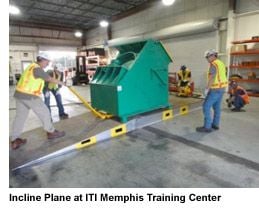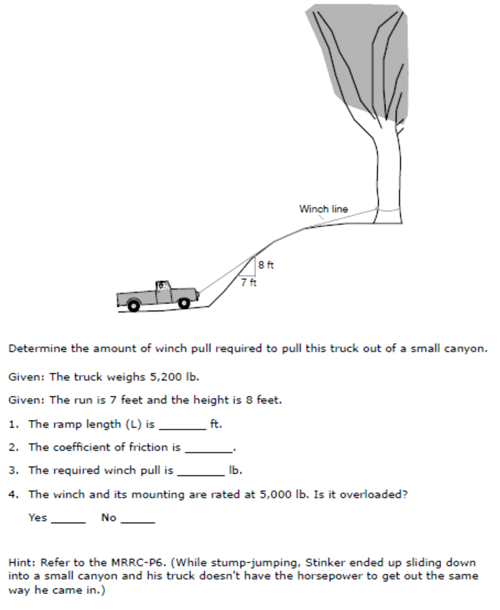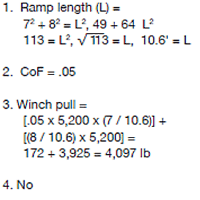Answers to the problem can be found below. Here is the "Rigging with Incline Planes" article reprinted if you missed it.
When towing or pulling a load up an incline the effort increases with the slope. Here are three key points that the rigging crew should address to ensure a successful operation.
1. Know the load’s weight and the rolling equipment’s CoF (coefficient of friction). You’ll notice the formulas offered from ITI’s Master Rigger’s Reference Card (at right) provide the means to calculate the required force if faced with a pull on a Level surface, Uphill or Downhill. Synthetic wheels such as provided with a common 3-point industrial rolling system offer a CoF of about .02, while steel rollers like those produced by Hilman, Multi-ton and Heavy Haul typically have a CoF of .05. Discovering the CoF while on a level plane is especially is helpful to refine the calculation for an uphill pull. Using a dynamometer in the winch line during a level pull can help finalize the approximate CoF for a particular set of rolling equipment.
2. Correctly accounting for the height, run and ramp length will help determine the values needed for either the Uphill or Downhill formula. These significantly influence the winch pull required and the sizing of the equipment; winch, snatch blocks, slings and shackles.
 3. We have all heard about “staying out of the bight”, which infers being clear of inside block angles and areas that can be in the line of fire if one experiences a sling or equipment failure. Some winches have controls immediately adjacent to the winch line, so the precaution is for non-essential personnel who aren’t critical to the load pull while the equipment is under tension. In many cases, essential personnel must be next to loaded winch lines during the operation. It is a matter of minimizing the risk to the best level, verifying the calculations, confirming the capacity of the rigging equipment, developing and following the proper procedure and adhering to all reasonable safety restrictions where possible. Having the right equipment, well maintained and inspected is a significant key to success.
3. We have all heard about “staying out of the bight”, which infers being clear of inside block angles and areas that can be in the line of fire if one experiences a sling or equipment failure. Some winches have controls immediately adjacent to the winch line, so the precaution is for non-essential personnel who aren’t critical to the load pull while the equipment is under tension. In many cases, essential personnel must be next to loaded winch lines during the operation. It is a matter of minimizing the risk to the best level, verifying the calculations, confirming the capacity of the rigging equipment, developing and following the proper procedure and adhering to all reasonable safety restrictions where possible. Having the right equipment, well maintained and inspected is a significant key to success.
Now, let’s have some fun. Try your hand at calculating the required force (tension in lbs.) by tackling the following workshop. It is based on the adventures of Stinker and Tinker, two brothers who always seem to be getting into a rigging challenge (Truck winches are not officially covered by ASME or OSHA.)
Assume:
Ramp Length = 10.6’ | Coefficient of Friction = .05
Use the Uphill formula:

Be sure to return for the answers which will be available on this Friday's ProRigger Blog, “Answer to Stinker’s Incline Plane”.
Answers to Stinker’s Incline Plane

How did you do?
Happy trails to my crane and rigging friends,
Mike Parnell
ITI – Field Services
P.S. Be looking for a new revision of ASME B30.7 Base Mounted Drum Hoist to be renamed B30.7 Winches, allowing for horizontal pulling. To accompany that is the ASME B30.26 Rigging Hardware volume which addresses rigging blocks.




COMMENTS